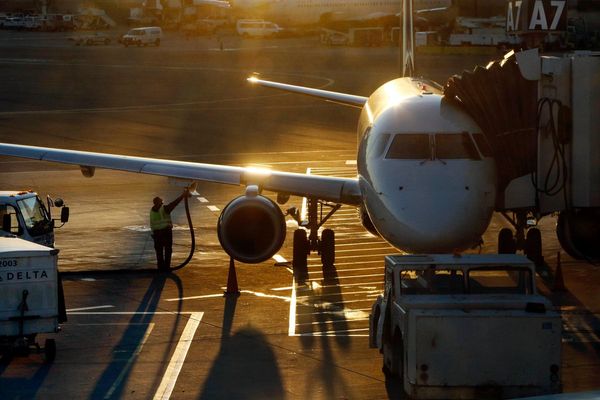City dwellers around the world have long been used to rapid delivery of takeaway food and, increasingly, groceries. But what they are not entirely used to – yet – is the sight of a robot pulling up to their front door. The co-founder of Skype, Ahti Heinla, believes his new venture is about to change that.
Heinla is the chief executive of Starship Technologies, a startup that, he claimed, is able to operate deliveries run by trundling robots at a small profit – and cheaper than a human delivery driver, even in small towns and villages where delivery has not previously been viable.
“We’ve solved everything that there is to solve,” Heinla said over lunch at a London hotel. “You could count how many years this is or how many months this is. But it will happen. It’s very clear it will happen.”
Residents of Manchester, Leeds, Cambridge and Milton Keynes in the UK, across Finland, and in Heinla and Starship’s home country of Estonia have all received food and groceries from the robots. They are becoming increasingly mainstream: they made an appearance at a 10 Downing Street garden party, and in an episode of The Bear, the hit US restaurant drama. Starship has made 8m deliveries with only 200 employees, but the company wants that number to rocket.
Heinla has already made a lot of money by co-creating software that became a verb: to Skype.
In 2000, Heinla was a video game developer who was hired by Skype co-founders Niklas Zennström and Jaan Tallinn, a fellow Estonian, to write some new code quickly. That became the filesharing programme Kazaa, and then, using similar tech, Skype. The six-strong founding team ended up selling to the online auction site eBay for $3.1bn (£2.3bn) in 2005.
That was an age ago in tech time – Skype closed this year, and Heinla says of that time”: “It’s almost like a different me.” Heinla would not reveal how much he made, but he could, he said, do the ex-tech boss thing flying in private jets if he wanted to.
But he does not want to. “I do see a lot of people in the world just trying to pursue money for money’s sake, even if they have enough,” the Estonian said. “I’m not like that. I’m sure I’m not interested in money or making money.
“I don’t need more. Why should I need it? Why do I have a palace? Why? What’s the point?”
Instead, Heinla said that making a success of autonomous delivery is one of the quickest ways that robotics could “touch everybody’s lives”.
After Skype, Heinla founded various businesses, including a shortlived social network effort. In 2014, he decided to enter a competition run by the US space agency Nasa to design a cheap Mars rover. Nasa did not choose the design, but what was good enough to cover extraterrestrial terrain could also handle wonky paving on urban roads. Radars, cameras, and ultrasound sensors watched out for obstacles, while the system learned from experience.
By 2017, the robots were driving in Estonia without an accompanying “safety walker” – which Heinla claimed were the first unsupervised robots driving autonomously in public. In 2018, the company launched its pilot commercial service on Milton Keynes’s predictable grid of streets. It is working with fellow Estonian tech company Bolt, the UK’s Co-op supermarket chain and the US food delivery company Grubhub, among others.
Starship may well have the largest fleet of autonomous vehicles in the world. However, it will face competition as autonomous technology improves. Rivals include US startups Serve Robotics and Nuro, plus Saudi Arabia-backed Noon. There could also be a challenge from the host of companies developing autonomous cars, ranging from the US’s Tesla to China’s Baidu.
Perhaps the most eye-catching rivals are those that have slipped the bonds of earth: the Dublin startup Manna Aero is already delivering coffees and pizzas using flying drones, while Amazon and Google sister company Wing have also tried out drone services.
A common complaint from many of these companies is that they are being held back by inconsistent rules. Starship has had to negotiate with each individual council in the UK, holding back its rollout. In contrast, the company is making 1m deliveries a year in Finland – where the government introduced national legislation on what robots were allowed on pavements – to a population of 5.6 million; in the UK far fewer robots serve 69 million people.
“We are ready to invest in UK as well to expand larger in UK as well, but we would like this regulatory clarity as well,” he said. “We have lessrobots in the UK than we have in Finland. But we could have more, we could have much more.”
He cited the example of a potential customer in the UK that has delivery in 200 sites, but wants to add it in 800 more, including those outside big towns and cities.
“That is a unique part that robots could be doing,” said Heinla. “And we want to do that. We want to bring delivery to the small towns in the UK as well. We’re ready to invest in scale.”
Many economists and futurists have long warned that the rise of robots will take human jobs. Heinla argued that Starship’s robots are not stealing jobs, but rather will address the burgeoning demand for deliveries, while humans focus on longer and more complicated jobs. He also argued that robots will help smaller stores “to thrive economically and compete with the larger, more central operations”. “Giving more capabilities to people is useful,” he added.
Starship has raised just over €200m (£175m), with the last funding round led by Plural Partners in London and other venture capitalists primarily in Europe. That is far less than the billions raised in recent years by rapid delivery companies reliant on humans. However, many of those companies – Getir, Gorillas and Weezy, among others – flamed out after raising huge sums.
Robots have an upfront cost – several thousand pounds, but below €10,000, said Heinla – but overall costs per delivery are “comparable to what it costs with people, but it’s less”, he said, while declining to share precise figures. He said that Starship deliveries generate cash.
“We are not a fully profitable business yet, but I’m sure we will be,” he said.
Some retailers are sceptical that robots can be more efficient than human riders offered by the likes of Deliveroo and Uber Eats. However, Heinla argued that robots can work for restaurants and retailers in less densely populated urban areas because they do not need to be paid for idle time.
“Almost every company that does delivery will need this,” he said. “At some point it will be not even a choice, because it will just be so much cheaper to do it by robot.”







